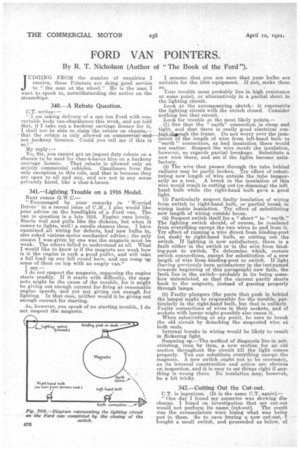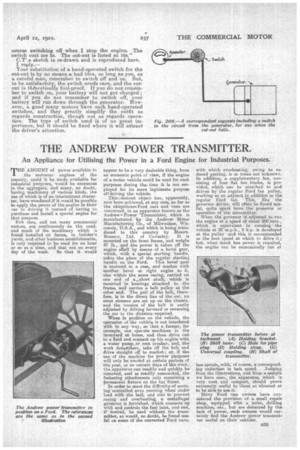FORD VAN• POINTERS.
Page 28

Page 29

If you've noticed an error in this article please click here to report it so we can fix it.
By R. T. Nicholson (Author of "The Book of the Ford").
JUDGING FROM the number of enquiries I receive, these Pointers are doing good service to " the man at the wheel." He is the man I want to speak to, notwithstanding the notice on the steamships. ,
340.—A Rebate Question.
C.T. writes:—
".1 am taking delivery of a one ton Ford with convertable body van-charabancs this week, and am told that, if I take out a hackney carriage licence for it,
I shall not be able to claim the rebate on chassis,— that the rebate is only allowed on-commercial ,agrclnot hackney licences. Could you tell me if this is so ? "
My reply:— , No, Sir, you cannot get an import duty rebate on a chassis to be used for char-a-bancs hire on a hackney carriage licence. That rebate is allowed only on strictly commercial vehicles. Omnibuses form the only exception to this rule, and that is because they are open to all and any, and are not in any sense privately hired, like a char-h-ba,ncs.
341.—Lighting Trouble on a 1916 Model.
Next comes G.W.C.—
" Encouraged by. your remarks re 'Worried Driver' in a recent issue of Calf., I also would like your advice on the headlights of a Ford van. The van in question is a late 1916. Engine runs lovely. Starts well and pulls like the dickens, but when it comes to lights, well! a candle shames them. I have examined all wiring for defects, had new bulbs in, also asked various motor mechanics' advice ; the only reason I was given by one was the magnets must be weak. The others failed to understand at all. What
I would like to know is if the magnets are weak how is it the engine is such a good puller, and will take a full load up any hill round here, and can romp up some of them on top with an •empty van." I say.— I do not suspect the magneto, supposing the engine starts readily. If it starts with difficulty, the magneto might be the cause of the trouble, for it might be giving out enough current for firing at reasonable engine speeds, and yet not giving out enough for lighting. In that case, neither would it be giving out enough current for starting.
As, however., you speak of no starting trouble, I do not suspect the magneto. I assume that you are sure that your bulbs are suitable for the 1916 equipment. If not, make them BO.
Your trouble most probably he in high resistance at some point, or alternatively in a partial short in the lighting circuit. Look at the accompanying sketch : it represents the lighting circuit with the switch closed. Consider nothing but that circuit.
Look for trouble at the most likely points.—
(1) See that the " earth" connection is clean and tight, and that there is really good electrical contact.thoough the frame. Do not worry over the insulation of the length of wire from left-hand bulb to
• "earth connection, as bad insulation there would not matter. Suspect the wire inside the insulation, however, as regards partial breakage. Substitute a new wire there, and see if the lights become satisfactory.
(2) The wire that passes through the tube behind radiator may be partly broken. Try effect of substituting new length of wire outside the tube temporarily as a, test. A break in the insulation of this • wire would result in cutting out (or dimming) the left • hand bulb while the right-hand bulb gave a good light. (3) Particularly suspect faulty insulation of wiring from switch to right-hand bulb, or partial break in wiring inside insulation. Try effect of substituting new length of wiring outside boom.
(4) Suspect switch itself for a " short" to " earth." The lighting switch should, of course, be insulated from everything except the two wires to and from it. Try effect of running a wire direct from binding-post (on dash) to right-hand bulb, so cutting out the switch. If lighting is now satisfactory, there is a fault either in the switch or in the wire from binding-post to switch. To determine which, restore switch connections, except for substitution of a new length of wire from binding-post to switch. If light (having previously been satisfactory in the testnamed towards beginning of this paragraph) now fails, the fault lies in the switch—probably in its being somehow uninsulated, so that the current partly shorts back to the magneto, instead of passing properly through lamps.
(5) Faulty plungers (the parts that push in behind the lamps) might be responsible for the trouble, particularly in the right-hand bulb, but that is unlikely. Faulty connections of wires in their sockets, and of sockets with lamps might possibly also cause it. When substituting at any paint, be sure to break the old circuit by detaching the suspected wire at both ends.
Internal breaks in wiring 'would be likely to result in flickering light.
Summing up.—The method of diagnosis lies in substituting, item by item, a new section for an old section throughout the circuit till the light comes properly. You can substitute everything except the magneto. A new switch ought not to be necessary, as its internal construction and action are obvious on inspection, and it is easy to set things right if anything is wrong there. Its insulation may; however, be a bit tricky.
342.—Cutting Out the Cut-out.
C.T. is ingenious. (It is the same C.T. again).—
" One day I found my ammeter was showing discharge. I found on investigation that my cut-out would not perform its name (cut-out). The result was the accumulators were losing what was being put in them. So to save buying a new cut-out, I bought a small switch, and proceeded as below, of
course switching off when I stop the engine. The switch cost me 2s. The out-out is listed at 16s."
C.r.s sketch is re-drawn and is reproduced here.
I reply.— Your substitution of a hand-operated switch for the tut-out is by no means abed idea, so long as you, as a careful man, reinember to switch off and on. But, to be satisfactory, the switch needs care, and the cutout is theoreticaNy fool-proof. If you do not remember to switch on, your battery will not get charged ; and if you do, not remember to switch off, your battery will run down through the generator. However, a good many motors have such hand-operated switches, and they greatly simplify the outfit as regards construction, though not as regards operation. The type of switch used is of no great importance, but it should be fixed where it will attract the driver's attention.
































